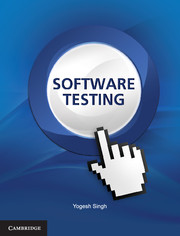Book contents
- Frontmatter
- Contents
- List of figures
- List of Tables
- Preface
- Acknowledgements
- 1 Introduction
- 2 Functional Testing
- 3 Essentials of Graph Theory
- 4 Structural Testing
- 5 Software Verification
- 6 Creating Test Cases from Requirements and Use Cases
- 7 Selection, Minimization and Prioritization of Test Cases for Regression Testing
- 8 Software Testing Activities
- 9 Object Oriented Testing
- 10 Metrics and Models in Software Testing
- 11 Testing Web Applications
- 12 Automated Test Data Generation
- Appendix I
- Appendix II
- Appendix III
- References
- Answers to Multiple Choice Questions
- Index
10 - Metrics and Models in Software Testing
Published online by Cambridge University Press: 05 November 2012
- Frontmatter
- Contents
- List of figures
- List of Tables
- Preface
- Acknowledgements
- 1 Introduction
- 2 Functional Testing
- 3 Essentials of Graph Theory
- 4 Structural Testing
- 5 Software Verification
- 6 Creating Test Cases from Requirements and Use Cases
- 7 Selection, Minimization and Prioritization of Test Cases for Regression Testing
- 8 Software Testing Activities
- 9 Object Oriented Testing
- 10 Metrics and Models in Software Testing
- 11 Testing Web Applications
- 12 Automated Test Data Generation
- Appendix I
- Appendix II
- Appendix III
- References
- Answers to Multiple Choice Questions
- Index
Summary
How do we measure the progress of testing? When do we release the software? Why do we devote more time and resources for testing a particular module? What is the reliability of software at the time of release? Who is responsible for the selection of a poor test suite? How many faults do we expect during testing? How much time and resources are required for software testing? How do we know the effectiveness of a test suite? We may keep on framing such questions without much effort. However, finding answers to such questions is not easy and may require a significant amount of effort. Software testing metrics may help us to measure and quantify many things which may help us find some answers to such important questions.
SOFTWARE METRICS
“What cannot be measured cannot be controlled” is a reality in this world. If we want to control something, we should first be able to measure it. Therefore, everything should be measurable. If a thing is not measurable, we should make an effort to make it measurable. The area of measurement is very important in every field and we have mature and establish metrics to quantify various things. However, in software engineering this ‘area of measurement’ is still in its developing stage and it may require a significant effort to make it mature, scientific and effective.
- Type
- Chapter
- Information
- Software Testing , pp. 420 - 452Publisher: Cambridge University PressPrint publication year: 2011



